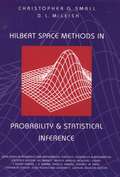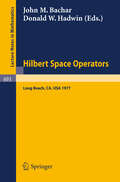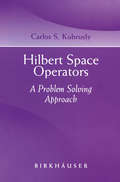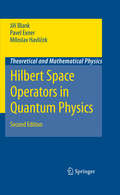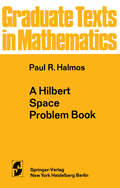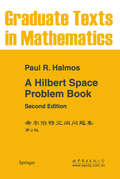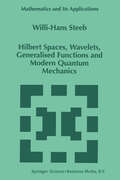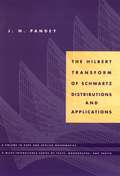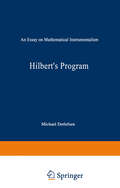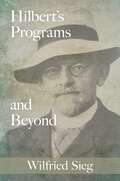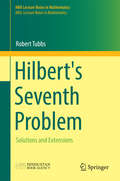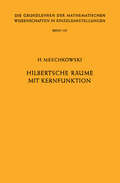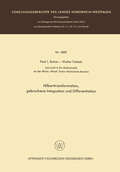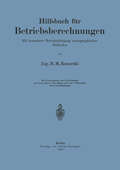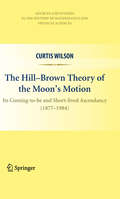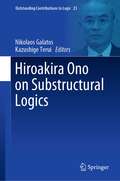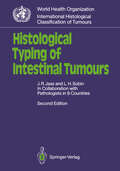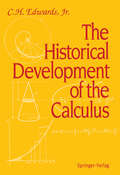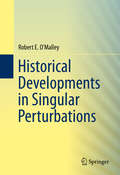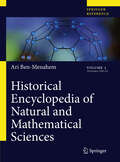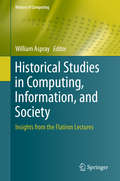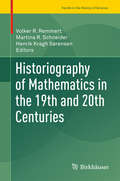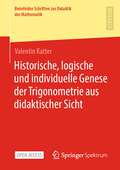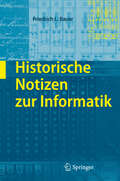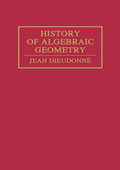- Table View
- List View
Hilbert Space Methods in Probability and Statistical Inference (Wiley Series in Probability and Statistics #920)
by Christopher G. Small Don L. McLeishExplains how Hilbert space techniques cross the boundaries into the foundations of probability and statistics. Focuses on the theory of martingales stochastic integration, interpolation and density estimation. Includes a copious amount of problems and examples.
Hilbert Space Operators: Proceedings, California State University Long Beach, Long Beach, California, 20-24 June, 1977 (Lecture Notes in Mathematics #693)
by J. M. Bachar D. W. HadwinHilbert Space Operators: A Problem Solving Approach
by Carlos S. KubruslyThis self-contained work on Hilbert space operators takes a problem-solving approach to the subject, combining theoretical results with a wide variety of exercises that range from the straightforward to the state-of-the-art. Complete solutions to all problems are provided. The text covers the basics of bounded linear operators on a Hilbert space and gradually progresses to more advanced topics in spectral theory and quasireducible operators. Written in a motivating and rigorous style, the work has few prerequisites beyond elementary functional analysis, and will appeal to graduate students and researchers in mathematics, physics, engineering, and related disciplines.
Hilbert Space Operators in Quantum Physics (Theoretical and Mathematical Physics)
by Jirí Blank Pavel Exner Miloslav HavlícekA Hilbert Space Problem Book (Graduate Texts in Mathematics #19)
by P.R. HalmosFrom the Preface: "This book was written for the active reader. The first part consists of problems, frequently preceded by definitions and motivation, and sometimes followed by corollaries and historical remarks... The second part, a very short one, consists of hints... The third part, the longest, consists of solutions: proofs, answers, or contructions, depending on the nature of the problem.... This is not an introduction to Hilbert space theory. Some knowledge of that subject is a prerequisite: at the very least, a study of the elements of Hilbert space theory should proceed concurrently with the reading of this book."
A Hilbert Space Problem Book (Graduate Texts in Mathematics #19)
by P.R. HalmosFrom the Preface: "This book was written for the active reader. The first part consists of problems, frequently preceded by definitions and motivation, and sometimes followed by corollaries and historical remarks... The second part, a very short one, consists of hints... The third part, the longest, consists of solutions: proofs, answers, or contructions, depending on the nature of the problem.... This is not an introduction to Hilbert space theory. Some knowledge of that subject is a prerequisite: at the very least, a study of the elements of Hilbert space theory should proceed concurrently with the reading of this book."
Hilbert Spaces, Wavelets, Generalised Functions and Modern Quantum Mechanics (Mathematics and Its Applications #451)
by W.-H. SteebThe Hilbert Transform of Schwartz Distributions and Applications (Pure and Applied Mathematics: A Wiley Series of Texts, Monographs and Tracts #27)
by J. N. PandeyThis book provides a modern and up-to-date treatment of the Hilberttransform of distributions and the space of periodic distributions.Taking a simple and effective approach to a complex subject, thisvolume is a first-rate textbook at the graduate level as well as anextremely useful reference for mathematicians, applied scientists,and engineers. The author, a leading authority in the field, shares with thereader many new results from his exhaustive research on the Hilberttransform of Schwartz distributions. He describes in detail how touse the Hilbert transform to solve theoretical and physicalproblems in a wide range of disciplines; these include aerofoilproblems, dispersion relations, high-energy physics, potentialtheory problems, and others. Innovative at every step, J. N. Pandey provides a new definitionfor the Hilbert transform of periodic functions, which isespecially useful for those working in the area of signalprocessing for computational purposes. This definition could alsoform the basis for a unified theory of the Hilbert transform ofperiodic, as well as nonperiodic, functions. The Hilbert transform and the approximate Hilbert transform ofperiodic functions are worked out in detail for the first time inbook form and can be used to solve Laplace's equation with periodicboundary conditions. Among the many theoretical results proved inthis book is a Paley-Wiener type theorem giving thecharacterization of functions and generalized functions whoseFourier transforms are supported in certain orthants of Rn. Placing a strong emphasis on easy application of theory andtechniques, the book generalizes the Hilbert problem in higherdimensions and solves it in function spaces as well as ingeneralized function spaces. It simplifies the one-dimensionaltransform of distributions; provides solutions to thedistributional Hilbert problems and singular integral equations;and covers the intrinsic definition of the testing function spacesand its topology. The book includes exercises and review material for all majortopics, and incorporates classical and distributional problems intothe main text. Thorough and accessible, it explores new ways to usethis important integral transform, and reinforces its value in bothmathematical research and applied science. The Hilbert transform made accessible with many new formulas anddefinitions Written by today's foremost expert on the Hilbert transform ofgeneralized functions, this combined text and reference covers theHilbert transform of distributions and the space of periodicdistributions. The author provides a consistently accessibletreatment of this advanced-level subject and teaches techniquesthat can be easily applied to theoretical and physical problemsencountered by mathematicians, applied scientists, and graduatestudents in mathematics and engineering. Introducing many new inversion formulas that have been developedand applied by the author and his research associates, the book: * Provides solutions to the distributional Hilbert problem andsingular integral equations * Focuses on the Hilbert transform of Schwartz distributions,giving intrinsic definitions of the space H(D) and its topology * Covers the Paley-Wiener theorem and provides many importanttheoretical results of importance to research mathematicians * Provides the characterization of functions and generalizedfunctions whose Fourier transforms are supported in certainorthants of Rn * Offers a new definition of the Hilbert transform of the periodicfunction that can be used for computational purposes in signalprocessing * Develops the theory of the Hilbert transform of periodicdistributions and the approximate Hilbert transform of periodicdistributions * Provides exercises at the end of each chapter--useful toprofessors in planning assignments, tests, and problems
Hilbert’s Program: An Essay on Mathematical Instrumentalism (Synthese Library #182)
by M. DetlefsenHilbert's Program was founded on a concern for the phenomenon of paradox in mathematics. To Hilbert, the paradoxes, which are at once both absurd and irresistible, revealed a deep philosophical truth: namely, that there is a discrepancy between the laws accord ing to which the mind of homo mathematicus works, and the laws governing objective mathematical fact. Mathematical epistemology is, therefore, to be seen as a struggle between a mind that naturally works in one way and a reality that works in another. Knowledge occurs when the two cooperate. Conceived in this way, there are two basic alternatives for mathematical epistemology: a skeptical position which maintains either that mind and reality seldom or never come to agreement, or that we have no very reliable way of telling when they do; and a non-skeptical position which holds that there is significant agree ment between mind and reality, and that their potential discrepan cies can be detected, avoided, and thus kept in check. Of these two, Hilbert clearly embraced the latter, and proposed a program designed to vindicate the epistemological riches represented by our natural, if non-literal, ways of thinking. Brouwer, on the other hand, opted for a position closer (in Hilbert's opinion) to that of the skeptic. Having decided that epistemological purity could come only through sacrifice, he turned his back on his classical heritage to accept a higher calling.
Hilbert's Programs and Beyond
by Wilfried SiegHilbert's Programs & Beyond presents the foundational work of David Hilbert in a sequence of thematically organized essays. They first trace the roots of Hilbert's work to the radical transformation of mathematics in the 19th century and bring out his pivotal role in creating mathematical logic and proof theory. They then analyze techniques and results of "classical" proof theory as well as their dramatic expansion in modern proof theory. This intellectual experience finally opens horizons for reflection on the nature of mathematics in the 21st century: Sieg articulates his position of reductive structuralism and explores mathematical capacities via computational models.
Hilbert's Seventh Problem: Solutions and Extensions (HBA Lecture Notes in Mathematics)
by Robert TubbsThis exposition is primarily a survey of the elementary yet subtle innovations of several mathematicians between 1929 and 1934 that led to partial and then complete solutions to Hilbert’s Seventh Problem (from the International Congress of Mathematicians in Paris, 1900). This volume is suitable for both mathematics students, wishing to experience how different mathematical ideas can come together to establish results, and for research mathematicians interested in the fascinating progression of mathematical ideas that solved Hilbert’s problem and established a modern theory of transcendental numbers.
Hilbertsche Räume mit Kernfunktion (Grundlehren der mathematischen Wissenschaften #113)
by Herbert MeschkowskiHilberttransformation, gebrochene Integration und Differentiation (Forschungsberichte des Landes Nordrhein-Westfalen #1889)
by Paul L. Butzer Walter TrebelsDiese Monographie behandelt die eindimensionale Hilberttransformation und die ge brochene Integration auf der reellen Zahlengeraden. Da sich viele der Beweise auf die Fouriertransformation für Lp-Funktionen (1 ~ P ~ 2) stützen, haben wir in Kapitel 1 alles Nötige aus der Theorie der Fouriertransformation für Funktionen einer Veränder lichen systematisch zusammengestellt. Weiterhin haben wir uns erlaubt, die wohl bekannten Eigenschaften der Hilberttransformation ohne Beweis vorauszusetzen und weniger bekannte ausführlich zu beweisen. Der Schwerpunkt der Monographie liegt bei den Kapiteln 3-6, deren Ergebnisse zum großen Teil neu sind. Da in der Einleitung über die Problemstellung und über die Resultate näher berichtet wird, sei an dieser Stelle nur erwähnt, daß Ausgangspunkte unserer Überlegungen Arbeiten folgender Mathematiker sind: S. BOCHNER, J. L. B. COOPER, W. FELLER, G. H. HARDY, J. E. LITTLEWOOD, G. O. OKIKIOLU, M. RIESZ, E. C. TITCHMARSH und H. WEYL. Dadurch wird eine Einordnung unserer Ergebnisse gewährleistet. Unser besonderer Dank gilt Herrn Professor J. L. B. COOPER für viele fruchtbare Dis kussionen und wertvolle Ratschläge. Seine Vorträge im Aachener Kolloquium und seine Teilnahme an einer Tagung, die der erstgenannte Verfasser im MATHEMATISCHEN FORSCHUNGSINSTITUT OBERWOLFACH im August 1963 abgehalten hat, waren stets an regend. Die Verfasser danken den Herrn Dr. E. GÖRLICH und H. JOHNEN für manche kritischen Bemerkungen und für ihre Mithilfe bei der Durchsicht von Teilen des Manuskripts und der Korrekturen, ferner Frl. K. REIMER-KELLNER, die das Manuskript mit großer Sorgfalt geschrieben hat, und dem Westdeutschen Verlag für sein Ent gegenkommen und die gute Ausstattung dieser Monographie.
Hilfsbuch für Betriebsberechnungen: Mit besonderer Berücksichtigung nomographischer Methoden
by NA KonorskiDieser Buchtitel ist Teil des Digitalisierungsprojekts Springer Book Archives mit Publikationen, die seit den Anfängen des Verlags von 1842 erschienen sind. Der Verlag stellt mit diesem Archiv Quellen für die historische wie auch die disziplingeschichtliche Forschung zur Verfügung, die jeweils im historischen Kontext betrachtet werden müssen. Dieser Titel erschien in der Zeit vor 1945 und wird daher in seiner zeittypischen politisch-ideologischen Ausrichtung vom Verlag nicht beworben.
The Hill-Brown Theory of the Moon’s Motion: Its Coming-to-be and Short-lived Ascendancy (1877-1984) (Sources and Studies in the History of Mathematics and Physical Sciences)
by Curtis WilsonThis book, in three parts, describes three phases in the development of the modern theory and calculation of the Moon's motion. Part I explains the crisis in lunar theory in the 1870s that led G.W. Hill to lay a new foundation for an analytic solution, a preliminary orbit he called the "variational curve." Part II is devoted to E.W. Brown's completion of the new theory as a series of successive perturbations of Hill's variational curve. Part III describes the revolutionary developments in time-measurement and the determination of Earth-Moon and Earth-planet distances that led to the replacement of the Hill–Brown theory in 1984.
Hiroakira Ono on Substructural Logics (Outstanding Contributions to Logic #23)
by Nikolaos Galatos Kazushige TeruiThis volume is dedicated to Hiroakira Ono life’s work on substructural logics. Chapters, written by well-established academics, cover topics related to universal algebra, algebraic logic and the Full Lambek calculus; the book includes a short biography about Hiroakira Ono. The book starts with detailed surveys on universal algebra, abstract algebraic logic, topological dualities, and connections to computer science.It further contains specialised contributions on connections to formal languages (recognizability in residuated lattices and connections to the finite embedding property), covering systems for modal substructural logics, results on the existence and disjunction properties and finally a study of conservativity of expansions. This book will be primarily of interest to researchers working in algebraic and non-classical logic.
Histological Typing of Intestinal Tumours (WHO. World Health Organization. International Histological Classification of Tumours)
by Jeremy R. Jass Leslie H. SobinThis classification is based primarily on the microscopic characteris tics of tumours. It is therefore concerned with the identification of cell types and histological patterns as seen by conventional light micro scopy. In general, time-honoured terms have been retained. Syn onyms are listed only if they have been widely used or if they are con sidered to be important for understanding the disease process. In such cases, the preferred term is given first, followed by the synonym in parentheses. The individuality of a tumour manifests itself principally in its histological appearance and the extent of spread at the time of diag nosis. This volume is concerned only with the histological classific ation of tumours. Anatomical extent or staging is covered in the TNM Classification.! The histological classification of a tumour de pends on two main parameters, typing and grading, and a number of additional parameters which may apply to selected examples. Histological Typing This divides tumours of a given organ into different types according to their direction of differentiation. Although this may frequently in dicate the underlying histogenesis of the tumour, it may be difficult or impossible to identify the cell of origin. Note is taken of the structure and function of cell types, as well as the overall growth pattern of the tumour, with the aim of matching these features to those of a normal tissue found in the same organ.
The Historical Development of the Calculus (Springer Study Edition)
by C.H.Jr. EdwardsThe calculus has served for three centuries as the principal quantitative language of Western science. In the course of its genesis and evolution some of the most fundamental problems of mathematics were first con fronted and, through the persistent labors of successive generations, finally resolved. Therefore, the historical development of the calculus holds a special interest for anyone who appreciates the value of a historical perspective in teaching, learning, and enjoying mathematics and its ap plications. My goal in writing this book was to present an account of this development that is accessible, not solely to students of the history of mathematics, but to the wider mathematical community for which my exposition is more specifically intended, including those who study, teach, and use calculus. The scope of this account can be delineated partly by comparison with previous works in the same general area. M. E. Baron's The Origins of the Infinitesimal Calculus (1969) provides an informative and reliable treat ment of the precalculus period up to, but not including (in any detail), the time of Newton and Leibniz, just when the interest and pace of the story begin to quicken and intensify. C. B. Boyer's well-known book (1949, 1959 reprint) met well the goals its author set for it, but it was more ap propriately titled in its original edition-The Concepts of the Calculus than in its reprinting.
Historical Developments in Singular Perturbations
by Robert E. O'MalleyThis engaging text describes the development of singular perturbations, including its history, accumulating literature, and its current status. While the approach of the text is sophisticated, the literature is accessible to a broad audience. A particularly valuable bonus are the historical remarks. These remarks are found throughout the manuscript. They demonstrate the growth of mathematical thinking on this topic by engineers and mathematicians.The book focuses on detailing how the various methods are to be applied. These are illustrated by a number and variety of examples. Readers are expected to have a working knowledge of elementary ordinary differential equations, including some familiarity with power series techniques, and of some advanced calculus.Dr. O'Malley has written a number of books on singular perturbations. This book has developed from many of his works in the field of perturbation theory.
Historical Studies in Computing, Information, and Society: Insights from the Flatiron Lectures (History of Computing)
by William AsprayThis is a volume of chapters on the historical study of information, computing, and society written by seven of the most senior, distinguished members of the History of Computing field. These are edited, expanded versions of papers presented in a distinguished lecture series in 2018 at the University of Colorado Boulder – in the shadow of the Flatirons, the front range of the Rocky Mountains. Topics range widely across the history of computing. They include the digitalization of computer and communication technologies, gender history of computing, the history of data science, incentives for innovation in the computing field, labor history of computing, and the process of standardization. Authors were given wide latitude to write on a topic of their own choice, so long as the result is an exemplary article that represents the highest level of scholarship in the field, producing articles that scholars in the field will still look to read twenty years from now. The intention is to publish articles of general interest, well situated in the research literature, well grounded in source material, and well-polished pieces of writing. The volume is primarily of interest to historians of computing, but individual articles will be of interest to scholars in media studies, communication, computer science, cognitive science, general and technology history, and business.
Historiography of Mathematics in the 19th and 20th Centuries (Trends in the History of Science)
by Volker R. Remmert Martina R. Schneider Henrik Kragh SørensenThis book addresses the historiography of mathematics as it was practiced during the 19th and 20th centuries by paying special attention to the cultural contexts in which the history of mathematics was written. In the 19th century, the history of mathematics was recorded by a diverse range of people trained in various fields and driven by different motivations and aims. These backgrounds often shaped not only their writing on the history of mathematics, but, in some instances, were also influential in their subsequent reception. During the period from roughly 1880-1940, mathematics modernized in important ways, with regard to its content, its conditions for cultivation, and its identity; and the writing of the history of mathematics played into the last part in particular. Parallel to the modernization of mathematics, the history of mathematics gradually evolved into a field of research with its own journals, societies and academic positions. Reflecting both a new professional identity and changes in its primary audience, various shifts of perspective in the way the history of mathematics was and is written can still be observed to this day. Initially concentrating on major internal, universal developments in certain sub-disciplines of mathematics, the field gradually gravitated towards a focus on contexts of knowledge production involving individuals, local practices, problems, communities, and networks. The goal of this book is to link these disciplinary and methodological changes in the history of mathematics to the broader cultural contexts of its practitioners, namely the historians of mathematics during the period in question.
Historische, logische und individuelle Genese der Trigonometrie aus didaktischer Sicht (Bielefelder Schriften zur Didaktik der Mathematik #10)
by Valentin KatterIn diesem Open-Access-Buch führt Valentin Katter eine umfassende didaktisch orientierte Sachanalyse unter historisch-, logisch-, und individualgenetischen Gesichtspunkten durch, mit der es ihm möglich ist, systematisch sechs Grundvorstellungen zum Sinusbegriff zu identifizieren. Anhand detaillierter Videoanalysen zeigt der Autor anschließend, wie diese Grundvorstellungen genutzt werden können, um Denkprozesse von Lehramtsstudierenden in kooperativen Problemlösesituationen zu rekonstruieren. Diese Rekonstruktionen gewähren einen Einblick in das komplexe individuelle Netz von Vorstellungen und ermöglichen es, das Potential und mögliche Hindernisse, die in ihm stecken, auszuloten.
Historische Notizen zur Informatik
by Friedrich L. BauerDie Informatik selbst ist eine junge Wissenschaft, ihre Wurzeln aber reichen weit in die Vergangenheit zurück. Der Autor zeigt dies auf unterhaltsame Weise und gleichzeitig mit mathematischer Strenge anhand zahlreicher Facetten aus der Geschichte der Informatik. Die Beiträge sind über viele Jahre in der Zeitschrift Informatik Spektrum erschienen und erscheinen nun erstmals gesammelt als Buch.
History Algebraic Geometry
by Suzanne C. DieudonneThis book contains several fundamental ideas that are revived time after time in different guises, providing a better understanding of algebraic geometric phenomena. It shows how the field is enriched with loans from analysis and topology and from commutative algebra and homological algebra.
